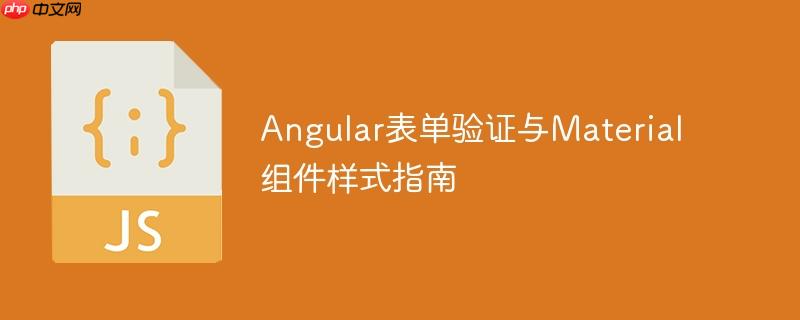
本教程深入探讨了angular应用中常见的两个问题:响应式表单的跨字段验证(以密码确认为例)以及Angular Material组件样式未正确加载的问题。文章详细介绍了如何通过自定义表单组验证器实现复杂的字段间校验逻辑,并提供了确保Material组件样式正确渲染的解决方案,包括模块导入和常见样式配置检查,旨在帮助开发者构建健壮且美观的用户界面。
解决Angular表单跨字段验证问题
在angular响应式表单中,处理依赖于多个字段的验证逻辑(如密码确认)是一个常见需求。原始代码中,getconfirmpasswordErrormessage() 函数虽然能够返回错误消息,但它仅仅是根据当前confirmpassword控件的状态来判断,并没有主动地“标记”该控件为无效。当confirmpassword控件没有内置的required或minlength等验证器错误时,即使password.value !== this.confirmpassword.value为真,confirmpassword.invalid也可能为false,从而导致错误消息不显示。
问题分析:
mat-error组件只有在其关联的FormControl被标记为invalid时才会显示。getConfirmPasswordErrorMessage()函数的作用是提供错误文本,但它本身并不能改变FormControl的valid或invalid状态。要实现跨字段验证,我们需要一个验证器来主动设置相关控件或表单组的错误状态。
解决方案:自定义表单组验证器
最推荐的解决方案是创建一个自定义验证器,并将其应用于包含相关字段的FormGroup。这样,验证器可以同时访问password和confirmPassword控件的值,并在它们不匹配时将错误附加到FormGroup上。
-
定义自定义验证器函数: 这个验证器将接收一个AbstractControl(在此例中是FormGroup)作为参数,并返回一个错误对象(如果存在错误)或NULL(如果验证通过)。
// src/app/validators/password-match.validator.ts import { AbstractControl, ValidatorFn, ValidationErrors } from '@angular/forms'; export const passwordMatchValidator: ValidatorFn = (control: AbstractControl): ValidationErrors | null => { const password = control.get('password'); const confirmPassword = control.get('confirmPassword'); if (!password || !confirmPassword) { return null; // 如果控件不存在,则不进行验证 } // 如果确认密码有值且与密码不匹配 if (confirmPassword.value && password.value !== confirmPassword.value) { // 在 confirmPassword 控件上设置一个 'passwordsMismatch' 错误 confirmPassword.setErrors({ passwordsMismatch: true }); return { passwordsMismatch: true }; // 也可以在 FormGroup 上设置错误 } else if (confirmPassword.hasError('passwordsMismatch') && password.value === confirmPassword.value) { // 如果之前有错误,但现在匹配了,则清除错误 confirmPassword.setErrors(null); } return null; // 验证通过 };注意: 上述示例在confirmPassword上直接设置了错误。另一种常见做法是在FormGroup上设置错误,然后在模板中根据FormGroup的错误状态来判断。对于用户体验,通常直接在确认密码字段下方显示错误更直观。
-
在组件中应用验证器: 将自定义验证器作为第二个参数传递给FormBuilder.group()方法,或者通过FormGroup.setValidators()方法设置。
// src/app/your-component.component.ts import { Component, OnInit } from '@angular/core'; import { FormGroup, FormControl, Validators, FormBuilder } from '@angular/forms'; import { passwordMatchValidator } from './validators/password-match.validator'; // 导入验证器 @Component({ selector: 'app-your-component', templateUrl: './your-component.component.html', styleUrls: ['./your-component.component.css'] }) export class YourComponent implements OnInit { hidepwd = true; hidepwdrepeat = true; registrationForm: FormGroup; constructor(private fb: FormBuilder) {} ngOnInit(): void { this.registrationForm = this.fb.group({ password: new FormControl('', [Validators.required]), confirmPassword: new FormControl('', [Validators.required]) }, { validators: passwordMatchValidator // 应用自定义验证器到 FormGroup }); // 监听密码字段的变化,当密码改变时重新验证确认密码 this.registrationForm.get('password')?.valueChanges.subscribe(() => { this.registrationForm.get('confirmPassword')?.updateValueAndValidity(); }); } get password() { return this.registrationForm.get('password') as FormControl; } get confirmPassword() { return this.registrationForm.get('confirmPassword') as FormControl; } getPasswordErrorMessage() { if (this.password.hasError('required')) { return 'Pflichtfeld'; } return ''; } getConfirmPasswordErrorMessage() { if (this.confirmPassword.hasError('required')) { return 'Pflichtfeld'; } // 检查自定义的密码不匹配错误 if (this.confirmPassword.hasError('passwordsMismatch')) { return 'Passwörter stimmen nicht überein'; } return ''; } register() { if (this.registrationForm.valid) { console.log('Form is valid!', this.registrationForm.value); // 执行注册逻辑 } else { console.log('Form is invalid!', this.registrationForm.errors); // 标记所有控件为 dirty/touched 以显示所有错误 this.registrationForm.markAllAsTouched(); } } } -
更新模板中的错误显示: 模板部分保持不变,因为mat-error会检查confirmPassword.invalid,而我们的验证器会正确地设置这个状态。
<!-- src/app/your-component.component.html --> <form [formGroup]="registrationForm"> <mat-form-field appearance="fill"> <mat-label>Passwort</mat-label> <input matInput [type]="hidepwd ? 'password' : 'text'" formControlName="password" required> <button mat-icon-button matSuffix (click)="hidepwd = !hidepwd" [attr.aria-label]="'Passwort anzeigen/verstecken'" [attr.aria-pressed]="hidepwd"> <mat-icon>{{hidepwd ? 'visibility_off' : 'visibility'}}</mat-icon> </button> <mat-error *ngIf="password.invalid && (password.dirty || password.touched)"> {{getPasswordErrorMessage()}} </mat-error> </mat-form-field> <br> <mat-form-field appearance="fill"> <mat-label>Passwort bestätigen</mat-label> <input matInput [type]="hidepwdrepeat ? 'password' : 'text'" formControlName="confirmPassword" required> <button mat-icon-button matSuffix (click)="hidepwdrepeat = !hidepwdrepeat" [attr.aria-label]="'Passwort anzeigen/verstecken'" [attr.aria-pressed]="hidepwdrepeat"> <mat-icon>{{hidepwdrepeat ? 'visibility_off' : 'visibility'}}</mat-icon> </button> <mat-error *ngIf="confirmPassword.invalid && (confirmPassword.dirty || confirmPassword.touched)"> {{getConfirmPasswordErrorMessage()}} </mat-error> </mat-form-field> <button mat-raised-button color="primary" (click)="register()">Registrieren</button> </form>注意: 移除了id属性和checkPasswordMatch()事件绑定,因为formControlName会自动处理绑定,且验证器会在值变化时自动触发。
注意事项:
- 响应式表单的核心: 验证逻辑应该封装在验证器中,而不是在事件处理函数中手动检查。
- updateValueAndValidity(): 当一个控件的值变化需要影响另一个控件的验证状态时,手动调用updateValueAndValidity()非常有用,如本例中密码变化时更新确认密码的验证。
- 错误显示时机: mat-error的*ngIf条件control.invalid && (control.dirty || control.touched)是Angular Material推荐的错误显示时机,确保用户完成输入或触碰后才显示错误。
修复Angular Material组件样式问题
Angular Material组件的样式通常通过预构建的CSS主题或自定义主题来应用。如果mat-raised-button等组件没有显示预期的样式(例如,没有阴影或背景色),最常见的原因是缺少必要的Angular Material模块导入。
问题分析:
Angular Material是模块化的,每个UI组件集(如按钮、表单字段)都有自己的NgModule。如果对应的模块没有被导入到你的应用模块中,那么即使你在模板中使用了相应的HTML标签,Angular也无法找到并应用这些组件的样式和行为。
解决方案:导入必要的Material模块
确保在你的Angular模块(通常是app.module.ts或一个专门的material.module.ts)中导入了所有你正在使用的Material组件模块。
-
导入MatButtonModule: 对于mat-raised-button,你需要导入MatButtonModule。
// src/app/app.module.ts 或 src/app/material.module.ts (如果你有单独的Material模块) import { NgModule } from '@angular/core'; import { BrowserModule } from '@angular/platform-browser'; import { BrowserAnimationsModule } from '@angular/platform-browser/animations'; // 动画模块 import { ReactiveFormsModule } from '@angular/forms'; // 响应式表单模块 // Angular Material Modules import { MatFormFieldModule } from '@angular/material/form-field'; import { MatInputModule } from '@angular/material/input'; import { MatIconModule } from '@angular/material/icon'; import { MatButtonModule } from '@angular/material/button'; // <--- 确保导入此模块 import { AppComponent } from './app.component'; import { YourComponent } from './your-component.component'; // 你的组件 @NgModule({ declarations: [ AppComponent, YourComponent ], imports: [ BrowserModule, BrowserAnimationsModule, // 需要这个模块来支持某些Material组件的动画 ReactiveFormsModule, MatFormFieldModule, MatInputModule, MatIconModule, MatButtonModule // <--- 在 imports 数组中添加它 ], providers: [], bootstrap: [AppComponent] }) export class AppModule { }提示: 建议创建一个单独的MaterialModule来管理所有Angular Material的导入和导出,这样可以保持AppModule的整洁。
// src/app/material.module.ts import { NgModule } from '@angular/core'; import { MatFormFieldModule } from '@angular/material/form-field'; import { MatInputModule } from '@angular/material/input'; import { MatIconModule } from '@angular/material/icon'; import { MatButtonModule } from '@angular/material/button'; @NgModule({ exports: [ MatFormFieldModule, MatInputModule, MatIconModule, MatButtonModule ] }) export class MaterialModule { }然后在app.module.ts中导入MaterialModule:
// src/app/app.module.ts import { MaterialModule } from './material.module'; // 导入你的MaterialModule @NgModule({ // ... imports: [ // ... MaterialModule // 使用 MaterialModule ], // ... }) export class AppModule { }
其他常见样式问题:
-
缺少全局主题CSS: 确保在你的angular.json文件的styles数组中或在src/styles.css(或src/styles.scss)中导入了Angular Material的预构建主题或自定义主题。例如:
/* src/styles.css */ @import '@angular/material/prebuilt-themes/indigo-pink.css'; /* 或者你自定义的主题 */
或在 angular.json 中配置:
"styles": [ "src/styles.css", "node_modules/@angular/material/prebuilt-themes/indigo-pink.css" ],
-
缺少BrowserAnimationsModule: 某些Material组件的动画效果需要BrowserAnimationsModule。确保它已导入到你的根模块(AppModule)中。
总结
本文详细阐述了Angular应用中表单验证和Material组件样式加载的常见问题及其解决方案。对于复杂的跨字段验证,推荐使用自定义FormGroup验证器,它能更优雅地处理字段间的依赖关系,并确保错误状态的正确传递。同时,对于Material组件样式不生效的问题,核心在于确保所有使用的Material组件模块都已正确导入到Angular模块中,并检查全局主题CSS是否已正确引入。遵循这些最佳实践,将有助于构建更健壮、更用户友好的Angular应用。



















